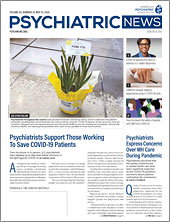“Boy, that escalated quickly,” said Ron Burgundy in the movie “Anchorman.” On February 18, Dr. Shabana Khan and I were invited to participate in a congressional briefing titled “Improving Access to Telemedicine.”
The briefing was moderated by then APA President Bruce Schwartz, M.D., and included a panelist representing the patient perspective. It was a standing-room-only audience consisting mostly of congressional aides and staffers.
As we say it, the charge was to lay out the administrative and regulatory impediments to more widespread adoption of telemedicine as an option for treatment delivery. Kudos to members of the APA Government Relations team who had gotten up to speed in a hurry and helped us to lay out the case.
Audience members reacted positively to our message, and a few people related their own experiences of seeking care through telemedicine outlets along with recognizing the great potential for doing much more.
Advocacy to Ease Telehealth Rules
We observed that Congress’ landmark opioid legislation (the SUPPORT Act, PL 115-271) eliminated the geographic requirements pertaining to “originating sites” for Medicare coverage of treatment of people with substance use disorder and co-occurring mental health disorders. While the law went so far as to allow such treatment to be provided to patients at home, the law did not waive these coverage restrictions for patients strictly receiving mental or behavioral health treatment. While a potential boon for those with addictive disorders, the law failed to address the lack of care for those with distinct or even co-occurring psychiatric conditions.
To help remedy this coverage gap, we emphasized APA’s support for the CONNECT for Health Act (HR 4932/S 2741), the EASE Behavioral Health Services Act (HR 5473), and the Telemental Health Expansion Act (HR 5201). Each of these bills proposed to eliminate the geographic requirements and allow Medicare coverage of in-home telepsychiatry.
The uniting theme for the briefing was to allow for expanded access to mental health and substance use disorder treatment by eliminating unnecessary barriers to telepsychiatry. We noted that the complex web of state licensure laws often served as an insurmountable barrier when trying to bring the most appropriate clinician into direct contact with a patient in need. Some states have yet to enact parity bills to assure that health care professionals delivering telemedical services will not be disadvantaged in terms of reimbursement. We spoke of clinicians who were hesitant to engage in telemedicine due to uncertainties about prescribing issues and how the Ryan Haight Act, while well intentioned and generally successful at helping to rein in rogue internet pharmacies, was still incomplete, and the Drug Enforcement Administration (DEA) had already missed a congressionally mandated deadline to delineate the telemedicine special registration provision of that law.
One cannot ignore the fact that the major federal payer, Medicare, has built-in disincentives against telemedicine including but not limited to origination-site disparities and practical prohibition against services delivered into inpatient settings. At the time of the briefing, rural sites were covered while most urban sites were not. Inpatient services were covered in an inconsistent and impractical fashion, and this further disadvantaged rural hospitals in need of access to specialty services. The Centers for Medicare and Medicaid Services (CMS) had earlier rejected the addition of initial inpatient hospital care as a covered telehealth service; however, CMS said it would cover certain subsequent hospital care services delivered via telemedicine. Unfortunately, the frequency limits around such services (once every three days for hospital inpatients, and once every 30 days for skilled nursing facility residents) were highly unrealistic and rarely if ever used. Had the goal been to limit utilization, the regulations made perfect sense. As it was, they remained yet one other significant barrier to telemedicine adoption.
Electronic Medical Record Problems
We noted several other concerns while acknowledging these might go beyond the scope of the presentation. Certainly, the appalling state of current electronic medical records systems has done nothing to inspire physicians to feel more favorably about employing optional technologies. The shameful lack of interoperability that continues to plague the electronic medical record world has mercifully been mostly solved in the world of videoconferencing. Due to the broad base of users (think nonmedical business applications), methods can generally be found to connect most interested users. Similarly, some of the earlier barriers to access are rapidly being solved through other means. The improvements in videoconferencing technology along with the expansion of bandwidth, even into most rural areas, have been phenomenal. The advent of portable devices and smartphones has given rise to a generation of digital natives and well-acclimated digital immigrants. The acceptance of videoconferencing as a modality of providing and receiving care is widely accepted by both clinicians and patients in the younger cohort.
HIPAA continues to haunt the intersection of medicine and technology. This law was passed for a different day and world. It has been a barrier to the flow of information between clinicians despite that not having been the intention. In a day when people are posting things to social media that they would have been embarrassed to tell a priest when HIPAA was enacted, this law seems anachronistic. Patients can speak to us (audio only) on an iPhone, yet the same device using its native videoconferencing app software (FaceTime) is not universally considered HIPAA secure. If that sounds confusing to us, you can trust that patients are baffled as well.
Progress Linked to COVID-19 Pandemic
Like most things involving government controls, we were prepared for a long and drawn-out process. After all, the Ryan Haight Act was enacted in 2008, and 12 years later we were still waiting on regulatory language for the telemedicine special license it described. That being said, it was an amazing sequence of events that began transpiring on March 17. Seemingly (if only temporarily), there came many favorable responses to items that had long been on our wish list.
First, CMS released guidance that allowed patients to be seen via live videoconferencing in their homes, without having to travel to a qualifying “originating site” for Medicare telehealth encounters, regardless of geographic location. Next we learned that, for the duration of this emergency declaration, the Department of Health and Human Services (HHS) had indicated that it was waiving HIPAA penalties for using non-HIPAA compliant videoconferencing software, allowing for popular solutions, such as Skype (basic) and FaceTime, to be used to conduct telehealth sessions.
While not explicitly requested initially, some relief was provided for telephone (audio only) communications with patients. As the public health crisis unfolded, CMS began allowing reimbursement (though a token amount) for patient-initiated “brief check-ins” via telephone (lasting around 5 to 10 minutes). Even this seemed to represent a new view of an old premise. Fortunately, on April 30 (retroactive to March 1) CMS announced that audio-only telephone services between patients and their physicians now include behavioral health services and that payments for these telephone visits are being increased to match payments for similar office and outpatient visits; however, given the newness of this policy change, it is unclear how it will specifically affect psychiatrists’ reimbursement rates.
Another relaxation of rules was the DEA’s suspension of the in-person exam requirement for telehealth-controlled substance prescription. This essentially provided to all DEA-registered clinicians the benefits long sought through the special registration and removed the roadblock created by the Ryan Haight delays. This step, along with the preceding one, is sufficient to allow any technologically capable practice to transfer its work to a telemedicine environment. Through a waiver or Modification of Requirements Under Section 1135 of the Social Security Act, the “requirements that physicians or other health care professionals hold licenses in the State in which they provide services, if they have an equivalent license from another State (and are not affirmatively barred from practice in that State or any State a part of which is included in the emergency area)” were waived as well.
These long-sought changes that we had expected to take years to enact went into effect in a matter of several hours. The underlying reason behind these sudden changes remains sad and potentially tragic. Nevertheless, having these much-wanted modifications go into effect is a very positive development on balance. There are, of course, practices that will struggle to make the transition, but without a doubt, the capability of seeing more of our “socially distanced” patients in their own homes (potentially from ours) protects not only our patients but also the larger medical workforce. Much work is yet to be done to fully realize all of the benefits in these changes. APA, the American Telemedicine Association, and other forward-thinking organizations have done their part to help get the word out, as have the various state medical associations.
Future Looks Bright for Telehealth
It is naive to say that things are forever changed, but it is hard to see how practices will ever return to their pre-COVID-19 routines. In-person care, of course, is not going away, but virtual care until now has been clearly underutilized. Alas, it has required a crisis of pandemic proportions to drive home that point. Nevertheless, the “genie is out of the bottle,” and patients and clinicians who have learned it is not only possible, but sometimes even preferable to receive and deliver care from their homes are unlikely to want to go back to the old ways. We’re pulling for the genie on this one. ■
References and Resources
Hilty DM, Ferrer DC, Parish, MB, Johnston B, Callahan EJ, Yellowlees PM (2013). The Effectiveness of Telemental Health. Telemedicine and e-Health. 2013; 19(6),444- 454 settings


